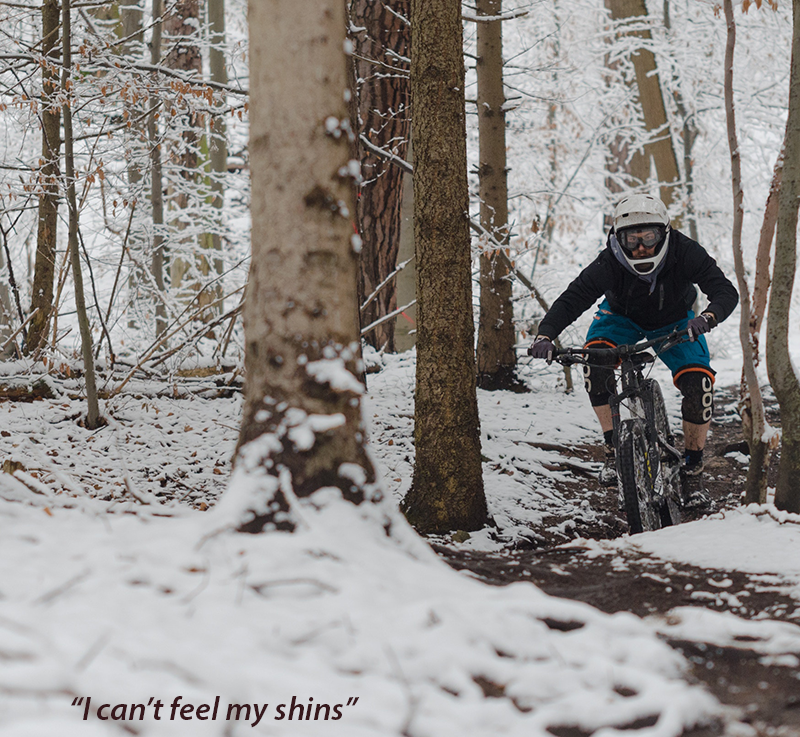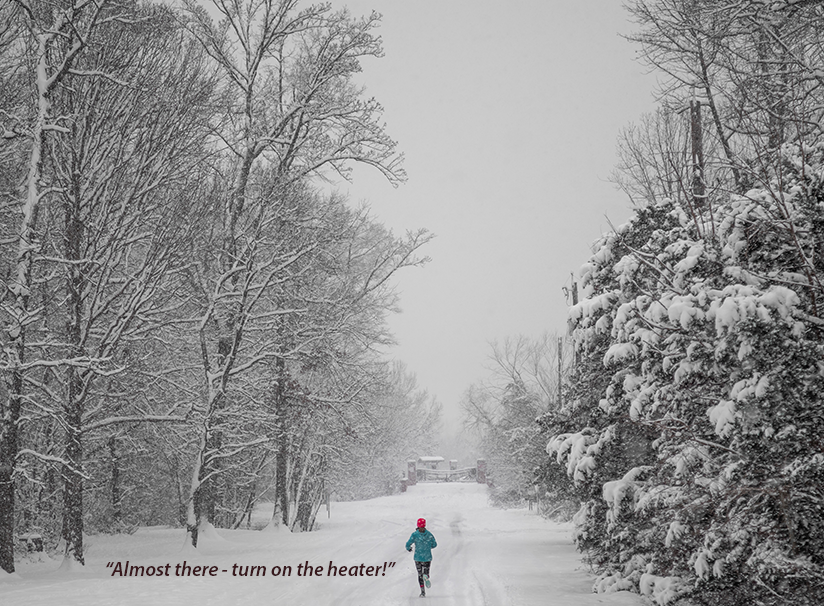Dom Cadden
Don’t let cold weather make you an indoor wuss. Sure, it seems hard to train outdoors when it’s cold. Part of that is in your head, but part of it is very real – performance declines as the temperature drops, you can burn more energy, and you may need to adjust your training type, intensity and even your technique. You can minimise all this by being well prepared, planning ahead and making a few adjustments. Now read this article and get out there!
Wrap it up
First up, get your gear right and dress like an onion – I’ll try not to cry when you strip off. The American College of Sports Medicine recommends wearing several light layers of clothing instead of one or two thick layers so you can take off or put layers back on to better match the temperature as you exercise. Multiple thin layers also trap air to provide insulation.
You first layer should be a thin layer of synthetic material that will draw sweat away from your body. Never use cotton as a base layer – it holds moisture. Sweat or any moisture will increase heat loss during exercise in the cold, so overdressing can lead to trouble, especially when it is windy. Think thermal tights and a breathable long-sleeve top. Next, add a layer of fleece, wool or a thermal jacket for insulation. Top this with a waterproof, windproof, breathable outer layer. In temperatures of -4°C / 24°F or less, three layers should be worn.
Both cyclists and runners should look for jackets that have a longer back tail to keep your butt warm and to stop shivers going up your spine.
Arm warmers can be a good option in semi-cold conditions, or an easily-removable extra layer in very cold conditions – you can roll them down or take them off and they’ll be small enough to fit in a waistband or jersey pocket.
At -4°C / 24°F or below, your legs need a wind breaking outer cover and you should consider a balaclava or thermal neck and face warmer. In this cold, there have been cases of penile injury (frozen penis snaps? Not sure on exact deets), so be careful with your choice of uninsulated shorts. Consider wearing underwear with an insulated front panel or compression shorts or tights over undies.
For cyclists, an often-quoted rule of thumb is to keep the knees covered any time it’s below 10°C / 50 °F so that they will be warm enough and properly lubricated to function at their best. thermal knee warmers are a good option to wear under full pants.
If you’re braving the open water, wear a wetsuit with full-length sleeves or at least a rashie with sleeves, because a lot of heat tends to escape from your armpits. Even if you do this, it’s also a good idea to swim with a partner in cold water, just in case your body seizes up in any way.
Finally, remember that in cold weather, sweaty clothes can quickly become freezing clothes. Take another set of clothes (or at least base layer gear) to change into as soon as you’re done. If that’s not possible, at least go somewhere they will dry off, e.g. in front of a fire or a car heater.
Be visible
If there’s any chance you’ll be running or cycling in the dark or even if you’re out in the gloomy light of an overcast day, then wear reflective gear and light-colored clothing. If there’s snow about, dress in bright colors or consider wearing a reflector vest.
Check the wear on your shoes before winter running – consider wearing shoes with a softer EVA cushioning in the cold
Shoes
Runners should check the wear on your shoes before winter running. Polyurethane soles won’t give the same support when it’s cold, so some people recommend using an ethylene-vinyl acetate (EVA) foam in cold weather conditions because it retains more padding strength. Even so, the EVA cushioning of the insole and midsole in running shoes tends to get stiffer at cold temperatures, so the shoe compresses less on impact, creating a smaller area of your foot is in contact with the shoe. The result is more localized pressure on your foot – it can feel like you are running on a much harder surface.
One adaptation you can make is to wear shoes with softer cushioning – this will work up to a point (below freezing it will feel like any other shoe). For winter, you might also consider a shoe that is a half-size or one size larger than usual to allow for an extra pair of wool socks that you can wear over a breathable compression sock.
For both cyclists and runners, a prime concern should be keeping your feet dry. For running, you may want some waterproof shoes in a material such as Gore-Tex when it’s very cold. At very least, if you use running shoes made with mesh materials, cover up the mesh.
The potential to lose body heat through your feet is already bad enough, but it only gets worse for cyclists. Prevent frozen toes with a heavier thermal cycling sock (i.e. made from synthetic fabrics). For milder winters, toe covers that fit over the ends of your shoes will help keep your toes dry and warm. For a bit more protection, cycle booties can be slipped over your entire shoe to insulate your foot and ankle.
If your toes go numb or you have a loss of feeling or a stinging sensation, then here’s an emergency action that can save your tootsies from frostbite: grab some plastic bags for picking up dog poop and slip them over your feet inside your shoes.
When you run and cycle, it can feel like the activity is warming up your body, but your hands can get freezing to the point of numbness. When in doubt, it never hurts to stash some gloves in your waistband or pocket. In wet and windy weather, you may need waterproof overgloves – wet gloves in cold wind can turn your fingers into blocks of ice.
One word of caution – consider your body as a closed-loop heat system. If your hands are still cold, you may not just need better gloves. It could be that you need warmer clothes on other parts of your body that may or may not actually feel cold.
In very cold conditions, speed work and high intensity interval training comes with risks, but long endurance is fine.
HEAD & NECK
Your head’s like a chimney – you can lose 25-40% of the body’s heat through that noggin, and with so much blood rushing through your neck, it’s not much better. If you can keep your head and neck warm, it’s a lot easier to keep the rest of your body warm.

Despite what you may have heard, there is no such thing as “frozen lungs” – or at least not while you are still breathing. Sure, many people can get “skier’s hack” (a passing cough) during or after training in the cold. Research at Marywood University in Pennsylvania proved that this comes from the dryness of cold air, which causes the “airway narrowing” that produces the cough. Lead researcher Ken Rundell suggests a quick fix is to use a scarf over your mouth and nose to trap your natural water vapor when you exhale, and then allow you to “recycle” it when you inhale. This is highly recommended for people with asthma.
You can find lightweight beanies that cover the ears for running and cycling, they’re thin enough to fit under a cap or helmet. For seriously cold weather, add a thermal neck warmer.
If you’re swimming outdoors, think about wearing two caps and/or lash out on a Neoprene swim cap, as Neoprene caps make a better buffer between your head and the cold water compared to latex or silicone caps.
Another tip for cold-water swimming: you can acclimatize to cold water quicker by throwing cold water on your face before you get in the water. The cold water triggers your lungs to gasp for air, and it’s better that this happens before you start to swim – it saves you some discomfort through the early stages of your training.
Plan your sesh
Cold weather might require you to be a little more flexible with your training. Start by checking the wind. Many runners, cyclists and coaches push the idea of planning your route so that you go into the wind for the first part of your session, then turn around to return with the wind when you might be slower and sweatier. The faster you move, the more heat you produce – but you also move more cold air across your body. This effect is magnified when you go into the wind, and reduced when you are travelling with it.
A study of marathon runners in Scotland found that even in air temperature of 10°C / 50 °F and winds of 26 kph / 16 mph several runners had temperatures significantly below the normal range when they finished the race. This had nothing to do with overall race time – it correlated more with runners who couldn’t hold their speed in the second half of the race.
If there’s snow other extremes of weather, here’s a good alternative for runners that still beats the treadmill: go to a multi-level parking garage and run up the ramps. If you’re cycling, pull out the mountain bike instead of your road bike. Mountain biking is great for building strength for cycling and the slower speeds and thicker, knobby tires make it less hairy to handle the colder air and icy surfaces. If snow sets in and becomes thick, cross-country skiing will build endurance and have good crossover for both cycling and running strength, while a snowshoe session makes a good replacement for running.
Shivering can use up to 400 calories per hour
Warm up indoors
Your muscles can’t warm up as effectively on a cold day. This makes connective tissues more brittle, keeping muscles from relaxing fully, and reducing synovial fluid (lubrication) in the joints. So when it’s cold, take time to do at least part of your warm-up indoors, and aim to do a little more warm-up than you would in warmer weather.
Train for the temperature
When it’s really cold, you might need to cool your expectations. Performance can decline at temperature below 10°C / 50°F. It’s only small at first – just a 1-2% increase in running time at 0°C / 32°F (although a snowy or icy surface and bulky clothes may make it more). At -7°C / 20°F, this increases to a 3-4% decline, at -12°C / 10°F it’s 5-6% and at -18°C / 0°F expect an 8-9% decline. Speed work also becomes difficult. Here’s why:
- Your muscles do not contract with the same intensity as they do in warmer temperatures because the transmission of impulses from the nervous system to muscles slows down.
- connective tissues become more brittle, which prevents muscles from relaxing fully.
- synovial fluid (lubrication) in the joints can be reduced.
- as the temperature drops, your body increases carbohydrate consumption as a source of fuel and reduces the reliance on fat. This means you drain your energy reserves faster than you would at warmer temperatures
- increased use of carbohydrates for energy increases lactic acid production
- Your body also becomes less efficient in using oxygen.
So in very cold conditions, speed work and high intensity interval training comes with risks, but long endurance is fine.
Change your running gait on snow. Go a bit – a bit wider and shorter with your stride to get more stability. You’ll still slip, so ease up on the pace because a big slip could land you with a nasty hamstring or groin strain.
Dehydration still happens
You can become dehydrated in the cold just as you would in the heat – it’s just that you might not even notice. Thirst won’t be a good guide – the cold can blunt your thirst mechanism and increase urine production. Then when you breathe in cold, dry air, your body warms and humidifies that air, which mean that you can lose a significant amount of water through respiration. All this means that it becomes as important to track your hydration in very cold weather as it is in very hot conditions.
Avoid cold drinks – they will take energy from your body, whereas a warm or tepid drink will provide heat it with heat. If you’re cycling, try to keep your drink in the back of your jersey or under your outer layer so it doesn’t freeze.
FOOD
In the cold, muscles may require more energy at a faster rate as there is an increased energy cost of movement. Energy may be lost just keeping warm – shivering can use up to 400 calories per hour! (and wear down your teeth if you’re a heavy shiverer like me). This and the increased use of carbohydrates for energy means that recovery nutrition in the first 30 minutes after training becomes even more important.
Finally… SOME PEOPLE JUST GET COLDER
Despite everything I’ve written above with temperature guides and numbers of layers to wear, etc., just be aware that some people just get colder than others.
Be wary that very lean runners or young runners have the potential to lose a lot of heat. Tall runners are also at a higher risk of hypothermia, because of their larger lungs.
It’s a contentious issue, but it’s believed that one reason women often feel colder than men arises from the fact that women typically have a higher ratio of surface area to volume, which causes them to have a more rapid rate of heat loss.
Much of this content appeared in articles on 2XU websites in Australia and North America.




